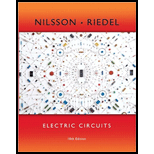
Electrical Circuits and Modified MasteringEngineering - With Access
10th Edition
ISBN: 9780133992793
Author: NILSSON
Publisher: PEARSON
expand_more
expand_more
format_list_bulleted
Concept explainers
Question
Chapter 16, Problem 4P
To determine
Derive the expressions of Fourier co-efficients
Expert Solution & Answer
Want to see the full answer?
Check out a sample textbook solution
Students have asked these similar questions
Control limits are to be established based on the average number inspected from the information in Exercise 8. What are these control limits and the central line? Describe the cases where individual control limits will need to be calculated.
Can you show why the answer is 3.55A
Can you show why the answer is 412 mA
Chapter 16 Solutions
Electrical Circuits and Modified MasteringEngineering - With Access
Ch. 16.2 - Objective 1–Be able to calculate the trigonometric...Ch. 16.2 - Prob. 2APCh. 16.3 - Derive the Fourier series for the periodic voltage...Ch. 16.4 - Compute A1 – A5 and θ1 – θ5 for the periodic...Ch. 16.5 - The periodic triangular-wave voltage seen on the...Ch. 16.5 - The periodic square-wave shown on the top is...Ch. 16.6 - a. 16.7 The periodic voltage function in...Ch. 16.8 - Derive the expression for the Fourier coefficients...Ch. 16.8 - Calculate the rms value of the periodic current in...Ch. 16.9 - Prob. 10AP
Ch. 16 - Prob. 1PCh. 16 - Find the Fourier series expressions for the...Ch. 16 - Prob. 3PCh. 16 - Prob. 4PCh. 16 - Prob. 5PCh. 16 - Prob. 6PCh. 16 - Prob. 7PCh. 16 - Prob. 8PCh. 16 - Prob. 9PCh. 16 - Prob. 10PCh. 16 - Prob. 11PCh. 16 - Prob. 13PCh. 16 - Prob. 14PCh. 16 - Prob. 15PCh. 16 - Prob. 16PCh. 16 - Prob. 17PCh. 16 - Prob. 18PCh. 16 - Prob. 20PCh. 16 - Prob. 21PCh. 16 - Derive the Fourier series for the periodic...Ch. 16 - Prob. 23PCh. 16 - Prob. 24PCh. 16 - Prob. 25PCh. 16 -
Show that for large values of C Eq. 16.24 can be...Ch. 16 - Prob. 29PCh. 16 - Prob. 30PCh. 16 - Prob. 32PCh. 16 - Prob. 33PCh. 16 - Prob. 34PCh. 16 - The triangular-wave voltage source, shown in Fig....Ch. 16 - Prob. 36PCh. 16 -
Find the rms value of the voltage shown in Fig....Ch. 16 - Prob. 38PCh. 16 -
Estimate the rms value of the periodic...Ch. 16 -
Estimate the rms value of the full-wave rectified...Ch. 16 - Prob. 41PCh. 16 - Prob. 42PCh. 16 - Prob. 43PCh. 16 - Prob. 44PCh. 16 - Prob. 45PCh. 16 - Prob. 46PCh. 16 - Prob. 48PCh. 16 - Make an amplitude and phase plot, based on Eq....Ch. 16 - Prob. 50PCh. 16 - Prob. 51PCh. 16 - Prob. 52PCh. 16 - Prob. 53PCh. 16 - Prob. 54PCh. 16 - Prob. 55PCh. 16 - Prob. 57P
Knowledge Booster
Learn more about
Need a deep-dive on the concept behind this application? Look no further. Learn more about this topic, electrical-engineering and related others by exploring similar questions and additional content below.Similar questions
- Correlation of experimental data for the average heat transfer coefficient for turbulent flow through tubes is given by NUD =hD/k=0.023 (Rep) 0.8 (Pr) 1/3 The Reynolds number, Re₁ = πD/v, is based on the tube diameter D, the average flow velocity ū and the kinematic viscosity v. Consider the flow of air and of water through tubes of identical size. Assume that the average velocity is the same for both fluids. If the average temperature for both fluids is 80°C, determine the ratio of the heat transfer coefficient of water to that of air.arrow_forwardDon't use ai to answer I will report you answerarrow_forwardDon't use ai to answer I will report you answerarrow_forward
- help on questions about singals and systems?arrow_forwardDon't use ai to answer I will report you answerarrow_forwardI have this code in matlab: clc; n=0:8; %20 harmonic indices jn=besselj(n,5);% 5 is the modulation index jnn=abs(jn); jn1 = 20.*log10(jnn*0.5); fc=1e+6; %carrier frequency fm=10e+3; %message frequency frq1 = (fc+n.*fm)*1e-06; frq2 = (fc-n.*fm)*1e-06; frequencies = [frq2,frq1]; %Lower and upper side magnitudes = [jn1,jn1]; %Magnitude of Jn corresponding to the frequencies % Plot figure; stem(frequencies, magnitudes, 'filled'); % Stem plot for spectrum visualization title('Magnitude Spectrum of FM Signal'); xlabel('Frequency (MHz)'); ylabel('Magnitude'); grid on; I am getting the lines opposite (the line should be traced from bottom to top not from top to bottom) as shown in the picture. How can I fix this?arrow_forward
arrow_back_ios
SEE MORE QUESTIONS
arrow_forward_ios
Recommended textbooks for you
 Introductory Circuit Analysis (13th Edition)Electrical EngineeringISBN:9780133923605Author:Robert L. BoylestadPublisher:PEARSON
Introductory Circuit Analysis (13th Edition)Electrical EngineeringISBN:9780133923605Author:Robert L. BoylestadPublisher:PEARSON Delmar's Standard Textbook Of ElectricityElectrical EngineeringISBN:9781337900348Author:Stephen L. HermanPublisher:Cengage Learning
Delmar's Standard Textbook Of ElectricityElectrical EngineeringISBN:9781337900348Author:Stephen L. HermanPublisher:Cengage Learning Programmable Logic ControllersElectrical EngineeringISBN:9780073373843Author:Frank D. PetruzellaPublisher:McGraw-Hill Education
Programmable Logic ControllersElectrical EngineeringISBN:9780073373843Author:Frank D. PetruzellaPublisher:McGraw-Hill Education Fundamentals of Electric CircuitsElectrical EngineeringISBN:9780078028229Author:Charles K Alexander, Matthew SadikuPublisher:McGraw-Hill Education
Fundamentals of Electric CircuitsElectrical EngineeringISBN:9780078028229Author:Charles K Alexander, Matthew SadikuPublisher:McGraw-Hill Education Electric Circuits. (11th Edition)Electrical EngineeringISBN:9780134746968Author:James W. Nilsson, Susan RiedelPublisher:PEARSON
Electric Circuits. (11th Edition)Electrical EngineeringISBN:9780134746968Author:James W. Nilsson, Susan RiedelPublisher:PEARSON Engineering ElectromagneticsElectrical EngineeringISBN:9780078028151Author:Hayt, William H. (william Hart), Jr, BUCK, John A.Publisher:Mcgraw-hill Education,
Engineering ElectromagneticsElectrical EngineeringISBN:9780078028151Author:Hayt, William H. (william Hart), Jr, BUCK, John A.Publisher:Mcgraw-hill Education,

Introductory Circuit Analysis (13th Edition)
Electrical Engineering
ISBN:9780133923605
Author:Robert L. Boylestad
Publisher:PEARSON

Delmar's Standard Textbook Of Electricity
Electrical Engineering
ISBN:9781337900348
Author:Stephen L. Herman
Publisher:Cengage Learning

Programmable Logic Controllers
Electrical Engineering
ISBN:9780073373843
Author:Frank D. Petruzella
Publisher:McGraw-Hill Education

Fundamentals of Electric Circuits
Electrical Engineering
ISBN:9780078028229
Author:Charles K Alexander, Matthew Sadiku
Publisher:McGraw-Hill Education

Electric Circuits. (11th Edition)
Electrical Engineering
ISBN:9780134746968
Author:James W. Nilsson, Susan Riedel
Publisher:PEARSON

Engineering Electromagnetics
Electrical Engineering
ISBN:9780078028151
Author:Hayt, William H. (william Hart), Jr, BUCK, John A.
Publisher:Mcgraw-hill Education,
Current Divider Rule; Author: Neso Academy;https://www.youtube.com/watch?v=hRU1mKWUehY;License: Standard YouTube License, CC-BY